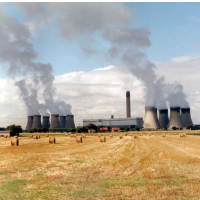EPA Loopholes Allow Biomass Facilities to Create more Toxic Pollution than Coal
 Polaniec biomass power plant in Poland (photo: GDF Suez)
Polaniec biomass power plant in Poland (photo: GDF Suez)
One of the biggest alternative energy sources in the United States has been accused of being just as polluting to the environment, if not more so, as coal, according to a new study.
Biomass plants, which burn wood waste to produce electricity, are producing more toxic emissions than coal-fired plants, thanks to federal regulatory loopholes, says Mary Booth, director of Partnership for Policy Integrity (PFPI), a nonprofit environmental organization. In her report, Booth says biomass facilities produce 50% more carbon dioxide than coal plants.
“Even the ‘cleanest’ biomass plants,” she claims, can emit more than 150% the nitrogen oxides, 600% the volatile organic compounds, 190% the particulate matter, and 125% the carbon monoxide of a coal plant per megawatt-hour.
Booth pins the blame on the U.S. Environmental Protection Agency (EPA) for allowing numerous loopholes in federal pollution rules that have permitted biomass to get away with spewing so much pollution into the atmosphere.
For instance, coal plants that emit 100 tons of a pollutant each year are required to obtain Prevention of Significant Deterioration (PSD) permits that mandate EPA oversight, among other things. But biomass plants are allowed to produce 250 tons of a pollutant before the same permit requirement kicks in for them. “We're talking about the same pollution, the same health effects, but biomass plants get to emit two and a half times as much,” Booth said.
The Biomass Power Association (BPA), which represents the industry, rejected Booth’s findings, calling her report an “81-page editorial.”
The report “showcases a fundamental misunderstanding of the science surrounding forestry and biomass, and a lack of familiarity with the state and federal laws governing energy and the environment,” BPA said in a press release.
Many environmental groups backed Booth’s report, including Clean Air Task Force, Center for Biological Diversity, Earthjustice, Greenpeace, Massachusetts Sierra Club, Natural Resources Defense Council and Southern Environmental Law Center, according to Inside Climate News.
Biomass is the third-largest renewable energy source in the nation behind wind and hydropower.
-Noel Brinkerhoff
To Learn More:
EPA Loopholes Allow Biomass to Emit More Toxic Air Pollutants Than Coal, Study Says (by Zahra Hirji, Inside Climate News)
Trees, Trash, and Toxics: How Biomass Energy Has Become the New Coal (by Mary S. Booth, Partnership for Policy Integrity)
Biomass Power Association Addresses Inaccurate Report (Biomass Power Association)
EPA Pushed Oil Companies to Pay for Non-Existent Biofuel Additive (by Matt Bewig, AllGov)
Why are Georgia and North Carolina Selling their Forests to Create Energy in Europe and the UK? (by Matt Bewig, AllGov)
- Top Stories
- Unusual News
- Where is the Money Going?
- Controversies
- U.S. and the World
- Appointments and Resignations
- Latest News
- Trump to Stop Deportations If…
- Trump Denounces World Series
- What If China Invaded the United States?
- Donald Trump Has a Mental Health Problem and It Has a Name
- Trump Goes on Renaming Frenzy






Comments